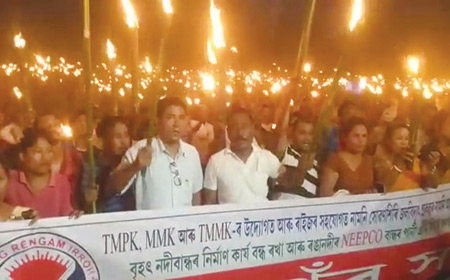Staff reporter
ITANAGAR, Aug 27: While the NHPC is gearing up to restart the construction of the 2000 mw Subansiri Lower Hydroelectric Project (SLHEP) in Gerukamukh following the recent NGT concurrence, various organizations in Assam have launched their ‘anti-mega dam movement’ afresh, opposing construction of the SLHEP with its present installed capacity and without ensuring foolproof protection measures for the people living downstream.
The influential Takam Mising Porin Kebang, the Mising Mimak Kebang and the Takam Mising Mime Kebang, along with other organizations of Assam on Tuesday organized protest marches across the state against the SLHEP, demanding ensuring protection of the lives and properties of the downstream people.
The organizations said they would continue to oppose the dam until and unless the capacity of the dam is reduced to a safe level and protection of the downstream people is ensured.
“We have no motive of obstructing the under-construction dam (SLHEP) or agitating against the government for no reason. Our prime concern is the people’s safety and security.
Until and unless the government takes adequate measures to ensure the safety and livelihood of the affected people, along with protection of the biodiversity, there is no question of restarting the construction of the SLHEP,” said the organizations in a joint press statement, clarifying their stand.
“We have been demanding reduction of the capacity of the dam since long, and are still reiterating the same. But sadly, neither the government nor the NHPC authorities are ready to listen to us,” the organizations said, accusing the government and the NHPC of showing a lackadaisical attitude towards the public’s grievances and demands.
The organizations also said they are deeply concerned over the report of the expert committee constituted by the central government and the government of Assam.
“Based on the report, we realized that the Lower Subansiri dam would have a devastating impact on its downstream areas,” they said.
The organisations claimed that, as per the expert committee report, “the dam is set up in a highly seismically active and high-rainfall zone,” and that the devastation it would unleash in the event of an earthquake would be beyond description.
They said providing compensation and rehabilitation to the affected families “would be no solution after the obliteration of human lives, aquatic animals, and flora and fauna.” The organisations expressed hope that the BJP-led government would exercise its power for the people’s protection and prosperity.
The organizations also vehemently opposed the upcoming 3000 mw Dibang Multipurpose Project in Lower Dibang Valley district, stating that the dam would bring drastic changes in the ecosystem and biodiversity, besides putting the lives and properties of the downstream people at stake.
Representatives of the organizations had in July visited various downstream sites of the 405 mw Ranganadi Hydroelectric Project (RHEP) and the 2000 mw SLHEP, and claimed to have found the people in those areas in a very “tragic” condition due to flooding by dam water. The team also claimed to have found the downstream protection works to be “very poor” and in a totally dilapidated condition due to the authorities’ “laxity and irresponsibility.”
“The people are the witnesses to the devastation caused by the 405 mw RHEP, the 60 mw Kurl Chhu Dam in Bhutan, the 100 mw Karbi Langpi Hydroelectric Project, and the 75 mw Daiyang Hydroelectric Project due to release of dam waters,” said the organizations.
“If these small dams of such capacities can cause catastrophes, then the impacts of mega dams with capacities of 2000 mw and 3000 mw would be beyond imagination,” they said.

